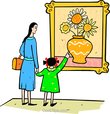Critique Prompts
Critique is the formal word for constructive feedback that you give to others about their artwork as well as feedback you receive about your own work. Critique is ESSENTIAL for growing and improving your work because it allows you to see your work from different perspectives and points of view. By collecting this information, you can make informed decisions about where you want your work to go from here.
The #1 goal of critique is to provide feedback. Be sure to keep it positive and respectful. Remember, constructive feedback and suggestions can still be positive and respectful! :) We want to be sure to maintain a safe, welcoming environment where everyone feels that they are able to share their work.
When you provide feedback, be sure to use both GLOWS and GROWS:
A GLOW is something that is successful! What's working really well? What do you like about the piece, and why? What looks good, and why? What should this person keep doing in this piece or in future pieces?
A GROW is suggestion (or a wonder) to help the artist strengthen their work. What would you recommend the artist change to strengthen this piece? What do you wonder about this piece? What's a question that you have for the artist?
(Don't know what to say? Try using phrases like "I wonder if you did this..." "Would you consider doing something like this..." "Have you thought about..." "I would really love to see..." "That would be cool if you...")
The #1 goal of critique is to provide feedback. Be sure to keep it positive and respectful. Remember, constructive feedback and suggestions can still be positive and respectful! :) We want to be sure to maintain a safe, welcoming environment where everyone feels that they are able to share their work.
When you provide feedback, be sure to use both GLOWS and GROWS:
A GLOW is something that is successful! What's working really well? What do you like about the piece, and why? What looks good, and why? What should this person keep doing in this piece or in future pieces?
A GROW is suggestion (or a wonder) to help the artist strengthen their work. What would you recommend the artist change to strengthen this piece? What do you wonder about this piece? What's a question that you have for the artist?
(Don't know what to say? Try using phrases like "I wonder if you did this..." "Would you consider doing something like this..." "Have you thought about..." "I would really love to see..." "That would be cool if you...")
Critique Levels & Examples (Aim for Level 3!)
Level 1 (Too basic; doesn’t give your viewer much information. Nice, but not very helpful in terms of feedback.)
"Cool."
"Looks good."
"Love it!"
Level 3
"I really like the use of the warm and cool colors next to each other, that's really successful in making it pop and bringing your attention to that area. The right side has a lot of the same blue though, I wonder if you could mix it up and add some greens or purples to give it more variety?"
Develop Craft
I learn and develop skills, techniques, and processes.
Stretch & Explore
I take risks, step outside my comfort zone, and I try new materials or techniques that are not familiar to me.
Engage & Persist
I solve and work through unexpected challenges and obstacles that occur.
Express
I communicate my interests, opinions, ideas, emotions, or identity to my audience through my art.
Envision
I use inspiration and my own ideas to create original art; I make a plan for my artwork and think about my next steps.
Observe
I look closer and see things that are usually overlooked; I create art from direct observation.
Reflect
I step back and analyze my work; I consider what is successful and what I could do differently.
Collaborate
I create artwork with others; I share inspiration/knowledge; I give and receive critical feedback.
Understand the Art World
I use inspiration/reference from other artists' work, art styles, and art movements; I use my art knowledge (composition, color theory, values, perspective, Elements & Principles, etc.) to create a visually compelling piece; I understand the difference between inspiration/reference and plagiarism.
Modified from Ian Sands / artofsouthb.com and Melissa Purtee
